|
|
 |
 |
 |
 |
| Royal Digital BS4100 Bluetooth GPS receiver review |
Date 24th November 2006
|
Article by Mike Barrett

Royal Digital is not a name that most people would know, but their products may well be. Until recently Royal Digital have been in the OEM/ODM markets producing products for household names. This has all changed now and they are starting to release products under their own brand. The first of these is the BS4100 Bluetooth GPS receiver.
|
The Royal Digital BS4100 BT GPS
Not only is the BS4100 Bluetooth GPS the first GPS device we have reviewed from Royal Digital, but it is also the first device with the Nemerix chipset I have got my hands on. For some time now SiRF have been the recognised leaders in the GPS chipset arena. How will the Nemerix chipset match up to it?
Well we have been using the GPS for a few months now and it has been all over the World, operating in all sorts of environments from the extreme Urban Canyons of New York, the scorching temperatures of Death Valley in America, the humidity of Taiwan, the salty air of the Great Barrier Reef in Australia, through to the typical down pours of the Welsh valleys. I am pleased to say that the Royal Digital BS4100 performed well in all conditions.
|
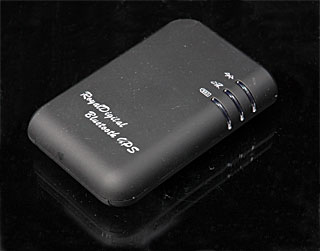 |
Manufacturer's Specifications
The following are the Technical Specifications as published on the Royal Digital website:
BS4100 is the first RoyalDigital's Bluetooth GPS receiver built-in Nemerix chipsets and designed with track switch which makes users power on and off the device easily. With the USB type power jack, users can charge the device through charger, laptop or desktop. BS4100 is powered by Nemerix technology and RoyalDigital's proprietary navigation algorithms which provide you more stable navigation data. Its 16 channel parallel receiver and fast signal acquisition insure that positioning is possible even in severe conditions, like in urban canyons and under foliage. The low power consumption in tracking mode makes your product cost effective and more competitive.
Chipset
Chipset :
Nemerix NJ1006A&NJ1030A
Frequency :
1575.42 MHz
Channels :
16
Cold start : 46 sec. typical. (Open sky)
Warm start : 34 sec. typical. (Open sky)
Hot start : 5 sec. Typical. (Open sky)
Fix Time After Obscuration[s] : < 3 s (Obscuration Time 1s to 100 s)
Acquisition Sensitivity (fix available) [dBm] : –147 dBm
Tracking Sensitivity [dBm] :
Better than –150 dBm
Position accuracy : 5m CEP 95%,w/o SA
Note: Open-sky, 24 hrs statistic, active antenna (signal range is between 30 to 49 dB/Hz).
Maximum altitude :
18,000 m
Maximum velocity : 515 m/s
Update rate :
Continuous operation: 1Hz
Communication Interface :
Compatible with Bluetooth device with Serial Port Profile(SPP)
Bluetooth™ Class 2 operation (up to 20 meter range)
Bluetooth™ Specification version2.0
Frequency: 2.400 to 2.480 GHz
Input Sensitivity:-80dBm
Output Level: 4dBm
Default protocol:
GGA, GSA, GSV, GLL, RMC, VTG
NMEA-0183 (V3.0)
Power
Current : 60mA typical
Power :
Input Voltage(DC):5V±5%
Backup power :
Main rechargeable Lithium battery to guarantee NVRAM data retention and RTC operation.
Mechanical requirements
Dimension : 79 x 50 x 17 (L x W x H, unit: mm)
Weight(with battery) : 68g
Environment
Operating temperature : -40 ~ 85oC
Storage temperature : -40 ~ 85 oC
Humidity : Up to 95% R.H. non-condensing @ +60 oC
External antenna
MMCX RF connector, 3.0V |
|
Compatibility
The Royal Digital BS4100 GPS receiver is a Bluetooth receiver conforming to version 2.0 protocol. What does this mean to us? Well in theory this means that it will work with any PDA, Computer or Mobile Phone that supports the Bluetooth Serial Port Profile (SPP) will work with it.
In practice I managed to get it working with every device I use except my XDA Exec (HTC Universal). It pairs and connects but does not send any data to any of my applications. I subsequently did a hard reset on the Exec and I was able to pair it and use it. Other than that I have it connected to my Nokia N60, Orange M500, iPaq 4700, Orange C500, Sony Vaio Laptop and Sony UX280P. Not at the same time of course...
|
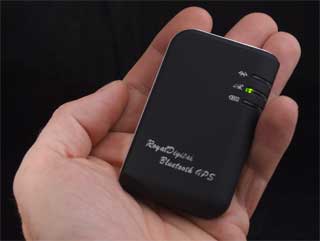
|
External Features
The Royal Digital BS4100 Bluetooth GPS is a pleasing departure from the functional hard, shiny plastic of most GPS receivers. With a soft matt black case and silver edging this receiver oozes style. The design will be more appealing than standard receivers.
Although when I first got it I was concerned that the finish would be a bit delicate and over time would deteriate and look tarnished that has not proven to be the case. After 3 months of use the only wear visible is on the lettering where it has been worn away a little from rubbing in my pocket.
On the back of the BS4100 is a small rubberised ring. This helps prevent the GPS receiver sliding around the dashboard whilst driving.
|
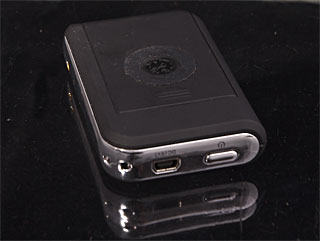 |
On the top of the Royal Digital BS4100 are the power switch and the power connector. In the corner is an attachment point for a lanyard.
Moving down the side of the GPS receiver you will see the socket for an external GPS antenna. The external antenna has a MMCX connection and will be required in situations where the GPS cannot be positioned with a clear view of the sky, such as in a truck or camper with an overhanging roof, or in a car with a coated windscreen.
Moving to the front of the GPS receiver there are 3 flashing indicator LEDs. These work slightly differently to normal and are as follows: |
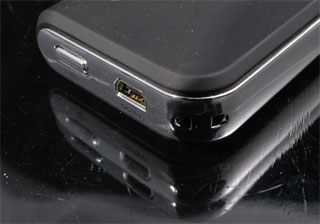 |
Top: Blue - Bluetooth activity. When the GPS is connected to a PDA, Computer or Phone then this LED flashes. If there is no connection then the light does not flash.
Centre: Green - Satellite status. If the GPS has a fix and is able to provide navigation data then the LED will be solid green. If the GPS is searching for satellite data then it will flash green.
Bottom: Red - Power Status. When connected to a power source this indicator will be solid red.
The indicators are slightly strange and a bit conflicting. I would have expected the Bluetooth and Satellite status to be consistent ie the blue LED to be on when the device is connected. |
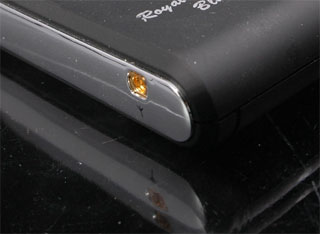 |
Power Sources
This brings me on nicely to the power of the receiver. Behind the battery cover is a removable 1000mAh battery. This may seem quite small when some of the competition use 1300 or even 1700 batteries, but don't worry because of the low power requirements of the Nemerix GPS chipset the Royal Digital GPS receiver will outlast most of them.
In my continuous running tests I was consistently achieving 19 to 20 hours run time from a single charge. The danger with performance like this is that you forget to charge the GPS when you need to, but then that would be user error not the fault of the GPS.
Whilst on the subject of charging the GPS receiver is charged using a standard mini-USB connector. This means that it can be charged from a number of power sources, including a PC USB cable. It should be noted that the GPS cannot be used a wired mouse. The GPS data is not sent via USB, only over the bluetooth wireless connection.
|
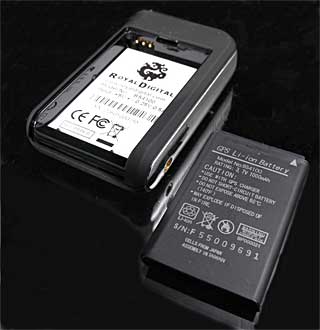 |
The Inside Job...
A PocketGPSWorld.com review wouldn't be quite the same without a peek inside the GPS receiver. And as
usual it just fell apart in my hands...
The picture to the right shows the top of the circuit board, which contains the GPS antenna and the three LED indicators. The GPS antenna is a standard ceramic patch antenna.
The picture below it shows the other side of the main circuit board. Not a lot to be seen here as it is all heavily shielded to prevent interference from electrical noise causing problems with the GPS reception. When the casing is replaced the battery is positioned just above the chips.
The Nemerix GPS Chipset
As mentioned above this GPS Receiver is using the Nemerix GPS Chipset (click here for the Nemerix site). The Nemerix GPS Chipset is reputed to be almost as sensitive as the SiRFStarIII GPS chipset, but has much less power requirements. This should result in a GPS receiver that is accurate in difficult environments, but does not drain your battery.
Our friend Guillaume at GpsPasSion.com has done an indepth comparison between a number of GPS chipsets for the technically minded of you. His article can be found here.
|
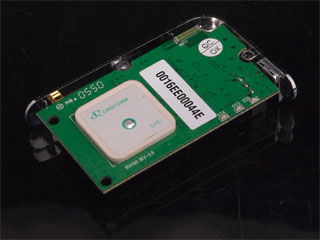
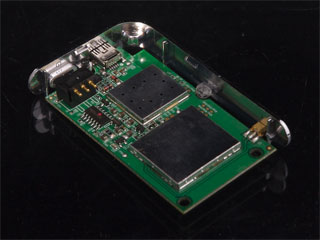
|
The Royal Digital BS4100 in use
As with all Bluetooth devices before you can use it you have to pair it with the device that you are using. With then Royal Digital this is done in the normal way for your host system. When asked for a passkey you must use 1234.
Once paired you will need to create the virtual serial port and then you are ready to configure your navigation application. Initially I was unable to get it to work with my XDA Exec, but it was fine with all my other systems. Eventually I had to perform a hard reset on the Exec and when I next tried to configure the BS4100 it worked. I never managed to get to the bottom of this.
Outside with a good view of the sky, fire the GPS up, connect to the navigation system, and wait for a GPS fix to provide your current location. The Royal Digital BS4100 is a bit slower than comparable SiRFStarIII devices, but unless you have a stop watch and are timing them side by side then you would not notice the difference. Where you will see a bigger difference is attempting to get a fix in a city with urban canyons. The Royal Digital BS4100 Nemerix device can take a lot longer than a SiRFStarIII GPS receiver.
Out and about with the receiver locked on to a good number of satellites the reported position is very accurate. The firmware in the Nemerix chipset seems to be less prone to inaccuracies caused by multipath GPS signals (where the signals received are bounced of the surrounding buildings). This tends to make the GPS track smoother than other devices.
A common problem in large cities with tall buildings is that the GPS signal gets bounced around a lot and the reported position can be in a parallel road. This tends not to happen with the BS4100. Unfortunately though this is offset by the fact that when the fix is lost it can be difficult to recover it.
I would point out that these tests were done in the centre of New York under the worst possible conditions. Moving 6,000 miles, then trying to get a strong fix in the middle of Manhattan's sky scrapers... Not exactly an ideal environment.
Moving out into the open spaces of the Australian Great Barrier Reef posed no problems for the receiver, and tucked away below decks in the dive boat I had an extremely strong signal all the way to the dive sites, and back again. I still had plenty of power in it for the next day as well. Unfortunately the same is not true of my PDA, which ran out of power and lost my recorded GPS tracks.
Back home driving my normal trips I have not had any occasion to find fault with the Royal Digital BS4100 GPS receiver. I tend not to drive much in London or other cities where Urban Canyons are an issue, and find that when I do I normally have a strong fix before entering these areas, that helps retain the fix until I leave. One common part of my regular journeys is the Dartford Tunnel or the Holmsdale Tunnel. Obviously no GPS will get a signal underground, but the important thing is how quickly it regains a fix at the other end... Well as before the BS4100 is slightly slower than a SiRFStarIII system, but only by a couple of seconds.
|
| Conclusions
I have made a lot of comparisons here to SiRFStarIII GPS receivers and the BS4100 does come out the overall loser in most of the comparisons made. One point to make though is that the difference between these systems is not huge. It is just a case of one being marginally better than another, but both of them being far and away better than anything that was around 2 years ago (and we thought that those were unbeatable then!!!).
The Royal Digital is a great GPS receiver that has stood the test of time in my testing. Possibly its best strength is the power consumption. This allows me to go out for a weekend in the hills without having to worry about an alternate power source to keep it charged.
Currently Royal Digital are looking for distributors and resellers worldwide. If you are a retailer interested in this GPS receiver contact sales@royaldigital.com
|
Pros
- Great power consumption
- Accuracy of positional data
- New stylish design
|
Cons
- Slightly slow time to fix
- Less sensitive than SiRFStarIII
- General availability
|
|
|
|
|
 |
 |
 |
 |
|
|